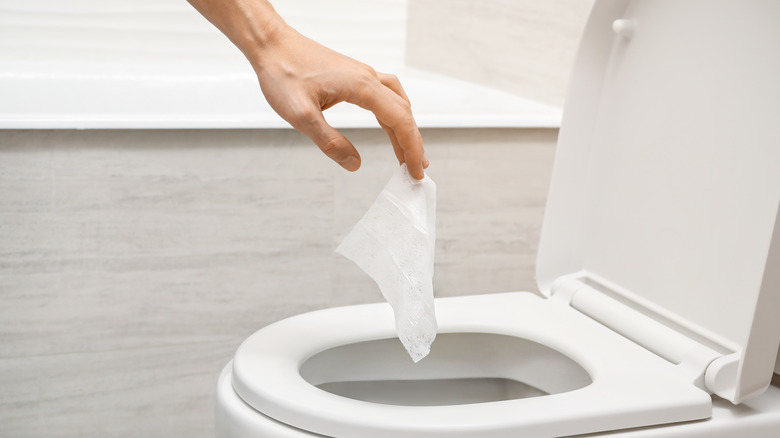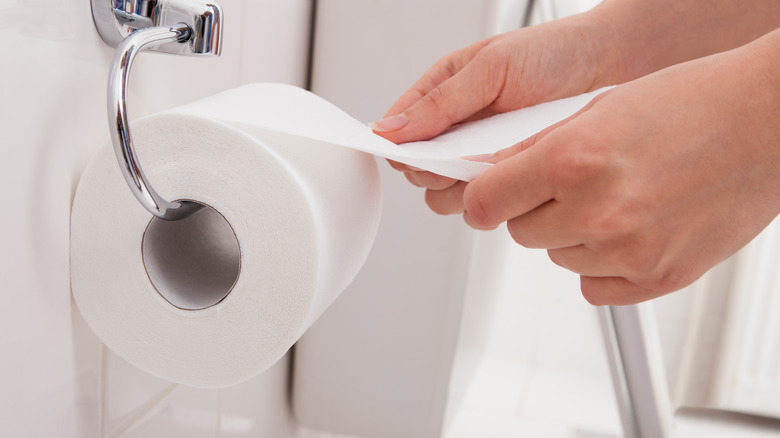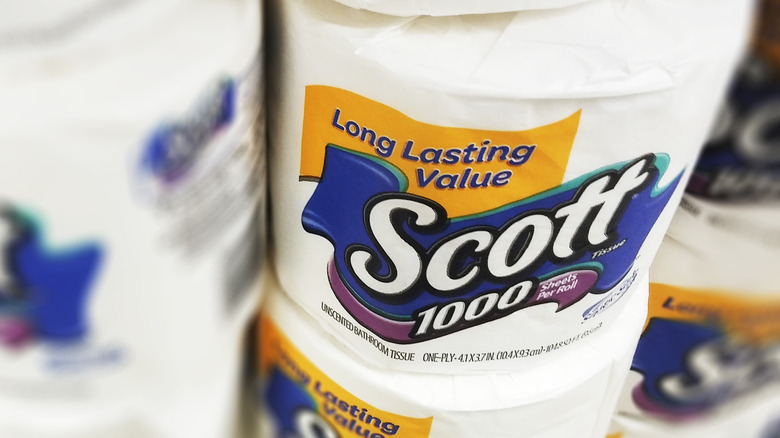Use This Trick To Determine Whether Your Toilet Paper Is Causing Damage To Your Pipes
You rise from doing your business and flush your toilet only to hear one of the most aggravating sounds one can hear in their home — the gurgling of a clogged toilet. Best case scenario, you're standing over the bowl lunging a plunger back and forth for longer than you'd like. Worst case scenario, you'll have to drop at least $100 on a plumber to fix it. The culprit that's causing this icky inconvenience could be that fancy toilet paper you're using. Long-term use of toilet-clogging paper can lead to damage to your pipes and plumbing system. Thankfully, there's a test you can try to see if you need to switch to a thinner ply. Just drop a few squares into the bowl to see if it dissolves quickly. If not, it might be too thick for your plumbing system.
While those expensive rolls might be better for your bum, they could be wreaking havoc on your pipes. Thick toilet paper can get stuck, causing a back-up in your plumbing. Old pipes and plumbing, low-flow toilets, and septic systems are especially susceptible to this. Using the wrong toilet paper can cause recurring clogs, which can take a toll on the overall plumbing system. This reoccurring distress can break your sewage lines, causing sewage back up in the walls, floors, or appliances of your home, creating unsanitary conditions and a far worse problem than you started with.
How to perform the toilet paper test
To test your toilet paper to see if it's safe for your toilet, you'll want to place one or two squares of it in your bowl. Let a few minutes pass before you check on it. After a few minutes, observe whether or not the toilet paper looks thinner and broken up or the same. If your toilet paper looks the same as when you tossed it in, then it's probably what has been clogging your toilet, and you should switch to a thinner ply of toilet paper.
Toilet paper should dissolve fairly quickly once it comes into contact with water. Toilet paper should typically break up within four minutes. If it doesn't, it could accumulate in your pipes and become harmful to your plumbing system. Toilet paper with a thinner ply will dissolve quickly. This allows it to flow through your plumbing system faster to prevent backup and clogs.
What to avoid putting in your toilet bowl
If you are concerned about toilet clogs or want to protect your plumbing, you'll want to avoid flushing thick toilet paper. Most of us are familiar with the two-ply; however, toilet paper also comes in one, three, and even four-ply. So, you should stick to a one or two-ply if you've been using the thicker stuff. The more ply a toilet paper has, the more expensive it usually is. The cheapest toilet paper is usually better on your septic system. So, by downgrading, you'll also save a few bucks.
Choose toilet paper that's stamped with a septic safe symbol, as it will be gentle enough to prevent clogs. While disposable wipes might say they are okay to be flushed, you should also avoid this if your toilet is prone to clogs. Cotton balls, paper towels, tissues, baby wipes, cigarette butts, cat litter, and dental floss should also never be flushed.


